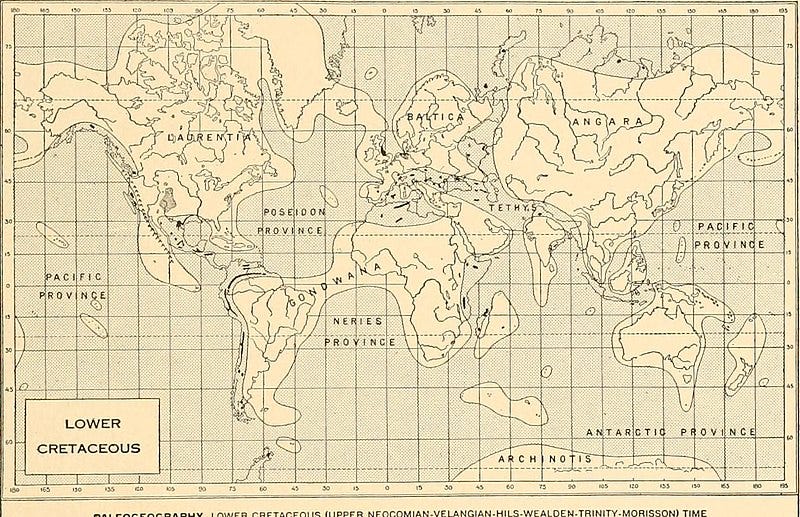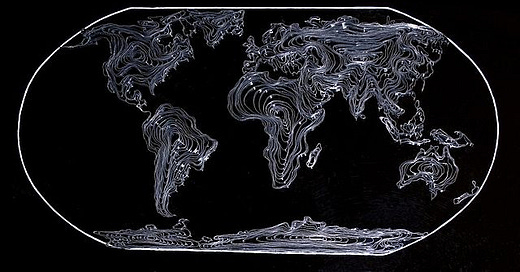Thanks for reading! I tend to archive older posts, but since this one has proven so popular, I’ll leave it free for now. If you like it, please leave a tip in the Tip Jar.
Alfred Wegener’s theory of continental drift is an example of an idea being roundly rejected by scientific consensus despite being basically correct. Wegener proposed the theory in 1912, but it wasn’t until the 1960s that it gained acceptance in the form of modern plate tectonics, and even then, it took time for the change to percolate down into the textbooks of kids in Podunk. My own father never learned in school that the continents move.
In The Rejection of Continental Drift: Theory and Method in American Earth Science, author Naomi Oreskes tells the story of the theory’s rejection and eventual acceptance. She starts the story with the problem of mountains.
Why Do Mountains Exist?
One major problem of 19th century geology was mountain building. How exactly did these massive rocky things come to be? There were two leading theories: The contraction theory of Austrian geologist Eduard Suess, and the geosyncline theory of American geologist James Dana.
The Seuss theory was the latest in a line of theories based on the idea that the earth was going through a long process of cooling and contracting. Suess argued that contraction caused the surface of the earth to wrinkle, like the skin of a drying apple. As the earth contracted and wrinkled, dry land would collapse down to become new ocean basin, and former ocean basin might become dry land. And the wrinkling, crinkling forces of this contraction formed mountains.
The Dana theory also made use of the idea that earth was once much hotter, a mass of molten rock. The continents, oceans, and mountains were all formed early on in cooling process, as the molten solidified. The continents cooled first, the ocean basins later, and the differential cooling and contracting produced a pressure that caused the edges of the continents to buckle and fold. These folds made mountains.
The two theories were similar in that both invoke a cooling and contracting of the earth, and both might nowadays get lumped together as contraction or cooling theories. But at the time they were seen as part of two very different theoretical camps. One camp was called uniformitarianism, the other catastrophism.
Uniformitarianism vs. Catastrophism
Scottish geologist Charles Lyell’s doctrine of uniformitarianism was the idea that the forces that shaped the earth in the distant past are the same as those we can see shaping it today. Thus geologists should limit themselves to explaining the earth with readily observable forces, like erosion by wind and rain.
Uniformitarianism stood in contrast to catastrophism, popularized by French naturalist George Cuvier. Catastrophism was the view that Earth was shaped by sudden, violent, large-scale events. Though Cuvier’s theories were secular, critics of catastrophism likened it to explaining things with the great Biblical flood.
Catastrophism was more popular in Europe, and so was Suess’s theory, which allowed for relatively sudden contractions that might plunge large areas of land down into the sea. He even proposed that, at one time in the past, all the continents were joined by land bridges into a supercontinent called Gondwanaland, which had since broken up as parts of it sank and flooded.
Uniformitarianism was more popular in America, and so was Dana’s theory, which relegated the cooling and contracting process to the early days when the Earth was just solidifying. In Dana’s theories the oceans and continents were in permanent locations ever since. American geologists emphasized Dana’s compatibility with uniformitarianism and called it “permanence” theory.
Matching the Facts
The two theories each explained different facts.
Suess’s theory was good at explaining biological reality. Scientists at the time were well aware of similarities between the animals living on different continents, such that a species in South America might look like the cousin of a species in Africa. In light of Darwin’s new theory of evolution, this was puzzling, as it suggested they had a common ancestor.
Fossil evidence pointed in the same direction: Sometimes fossils on one continent appeared to be exactly the same species as fossils found on another continent. Suess’s theory that the continents used to be connected into a single landmass, Gondwanaland, could explain this.
His theory, which held that sinking and crinkling could turn sea basin to dry land and back again, would also explain the strange puzzle of marine fossils found miles from the ocean, sometimes even on mountains.
Dana’s theory was good at explaining the geology of the Americas. His theory proposed that mountains should occur near the edges of continents, as in the Appalachians and the Andes. The patterns of rock folding he predicted was based on his observations of the Appalachians, and his theory that continents and ocean beds cooled at different rates was compatible with the fact that they were composed of different kinds of rock.
Each theory lacked the strengths of its competitor – Dana’s couldn’t explain fossils, and Suess’s couldn’t explain rock composition. And each had other anomalies. The structure of the Alps didn’t quite match the details of either. And neither theory knew what to make of the finding that mountains in general weren’t as heavy as they should be.
The Theory of Isostasy
In the 19th century scientists studied local variation in Earth’s gravity. Mountains are one source of variation: Those big piles of rock are massive enough that they exert a pull on anything standing next to them. It’s very slight, compared to the downward pull of the rest of the Earth, but its enough to make a plumb bob go ever so slightly off course.
The puzzle was that when scientists measured this effect, it was much less than they expected. This suggested there was some missing mass, as if the solid rock seen on the surface wasn’t so solid below. Measures of gravity taken in different locations uncovered a general pattern: The pull of low-lying areas was stronger than expected, the pull of high places was weaker than expected. The implication was that the low places were denser and heavier than the high ones.
This led to the theory of isostasy, which held that the continents and ocean basins “floated” over some sort of substrate, and that the continents stuck up higher because they were lighter and more buoyant. Eventually enough supportive evidence accumulated to convince the bulk of geologists in both America and Europe to accept some version or other of isostasy.
This did not bode well for theories of contraction.
The Death of Contraction Theory
The acceptance of isostasy crippled Suess’s theory, as it meant chunks of continents should not suddenly become dense enough to sink down and become ocean. The theory limped along as the only solution to the puzzle of fossil distributions, until the discovery of radioactivity delivered the coup de grace.
Radioactive decay gives off heat, and the earth is full of radioactive elements. This killed the assumption of long-term cooling, and led to the rejection of the Suess contraction theory.
The problem was, with Suess’ theory gone, there was no way to explain all those puzzling facts about the distribution of animals and fossils.
Enter Continental Drift
German meterologist Alfred Wegener was respected in his field but an outsider to geology. But he looked at a map and noticed what seems obvious to many: The continents look like a jig-saw puzzle, as if they would fit neatly together. Ergo, he though, they once did, but had since broken up and drifted apart. Thus in 1912 he announced the theory of continental drift.
Wegener’s theory of continental drift synthesized aspects of both isostasy and Suess’s contractionism. From isostasy he took the ideas of the continents being more or less buoyant on top of a mobile substrate. From Suess he took the idea that at one time the continents were connected into a super-continent called Gondwanaland. Only instead of being connected by now sunken land bridges, which isostasy said was impossible, they had butted directly up against one another before coming apart. His theory thus reconciled the evidence for isostasy with the biological and fossil evidence for contractionism.
Wegener actually wasn’t the first person to propose the basic idea of moving continents, but previous versions had never caught on and were largely forgotten. A major difference between Wegener and these predecessors is the sheer amount of effort he put into pointing out testable consequences of his idea and marshalling evidence that it was correct. He spent the next 18 years accumulating such evidence, cataloguing the ways that rock, mineral, and fossil deposits on the edge of one continent closely matched those on the edge of another. And when he died trekking across Greenland in 1930 it was in service of testing his theory.
Despite all this, geologists by and large rejected the theory. It did slighly better in Europe, where Alpine geologists – who had never quite been satisfied with any of the older theories of mountain building – were early adopters. But most European geologists thought it wrong, even if they were willing to grant it the status of wrong but potentially useful (a status once held by the Copernican model of the solar system). In America, the response was harsher, and US geologists rejected conintental drift with a passion. Oreskes doesn’t think it is obvious why this would be the case.
Why Did They Reject It?
The naïve view of why continental drift was rejected is that it was prima facie ridiculous: How could a whole continent float and move? It would be like explaining to an ancient that though he felt like he was standing still, he and the ground under his feet was actually hurtling around the sun at seventeen miles per second.
But Oreskes argues this isn’t so. The success of the theory of isostasy meant that geologists actually accepted, at least implicitly, the idea that continents float on a mobile substrate. For some reason, though, while floating continents were acceptable, drifting continents were a bridge too far.
Another common idea is that geologists rejected drift for lacking a causal mechanism: Wegener had no good theory about what made the continents move. Oreskes also disagrees with this.
For one, you could say the same thing about other theories that were more successful in the history of science. Isaac Newton famously said he feigned no hypotheses about how the force of gravity was transmitted from one object to another, and Darwin gained acceptance long before anybody understood genetics.
For another, by 1920, there was a plausible mechanism for how continents drifted. In that year three early converts to continental drift had proposed a theory of convection currents in the earth’s mantle that is basically the same mechanism we accept today. But mainstream geology kept rejecting continental drift for another forty years.
One problem lay in the most novel part of Wegener’s theory: The sheer extent of the horizontal motion of the continents, something far greater than the folding and wrinkling forces of the cooling earth theories. Even though it was said to be a slow and gradual process, the scale of it smelled like catastrophism. And the tide had been turning against catastrophism for a while.
This was less so in Europe and helps account for why Europeans were less hostile to the theory. US geologists, on the other hand, saw uniformitarianism as fundamental to the legitimacy of their field. It was what separated the science of geology from Biblical creationism, or any other crackpot view. Continental drift just seemed too far afield from uniformitarianis; it must be a crackpot idea.
Wegener’s work also ran afoul of other assumptions about how to do geology. American geologists had a pluralist view of theory, where none should be given pride of place. It was a virtue for a geologist to put forth multiple explanations, and to treat each equally, without showing favoritism or partisanship. Much like how ancient Romans were offended by Christians’ stubborn insistence that their god was the only real God, American geologists were irked by Wegener’s claim to have the right explanation for so many patterns.
Beyond that, American geologists were generally skeptical of theory-driven science. They cautioned one against what they saw as the theoretical autocracy of the European tradition and given examples of where theories had gone wrong in the past. American geologists emphasized plain description of the facts and wanted any theorizing to be held at a distance. One geologist even made a practice of never putting observation and conjecture on the same notebook page, reserving even-numbered pages for one and odd-numbered pages for the other. Publications in geology followed this logic, presenting facts first then inferences at the end, and these inferences were always phrased tentatively and noncommittally.
Wegener’s book violated these American norms. He had the temerity to advocate for his own ideas and argue that they were correct. His hard work in marshalling evidence for his theory was itself a kind of deviance, a sign of unscientific bias, a failure to be sufficiently distant and neutral. How could such a partisan be taken seriously? The translation of his work into English from German did not help, as his writing came across as unusually forceful and dogmatic.
Another norm he violated was the American belief that scientific discovery resulted from long hours of painstaking work: Sudden inspiration and serendipity were distrusted. Yet in his book Wegener openly admitted to having his idea suddenly, and of finding some of his initial supporting evidence by accident.
Attacks on Wegener were thus defenses of Americans way of doing geology.

The Long Exile
Continental drift found some early adherents, especially in Europe, and even in the US some prominent geologists and paleontologists were willing to discuss its potential.
Prominent paleontologist Charles Schuchert, for instance, was familiar with the fossil evidence for Seuss’s contraction theory and wanted to find an alternative theory that could explain it. While he spoke forcefully against continental drift in public, in private he would discuss its merits and even accept the existence of Gondwanaland. But ultimately, he was “saved” from having to accept continental drift by Bailey Willis’ new theory about how parts of the earth’s crust might uplift and then sink again, putting temporary land bridges back in the realm of possibility. Schuchert was well-aware of problems with the Willis theory, but eventually just dropped his criticisms and accepted it.
By 1932 the public debate over continental drift among US geologists was over: For the next twenty years very little was published about continental drift, and the geology students at top universities learned that rising and sinking land bridges were the explanation for there being similar animals and fossils on the different continents.
With Wegener dead and a new land-bridge theory dominant, continental drift was banished to the odd fringes of the profession. One geologist, Joseph Poland, recalls that at Harvard in the late 1930s it was only discussed “on the back stairs,” while Stephen Jay Gould claims that at Columbia in the 1950s anyone who advocated it was publicly ridiculed.
The Tide Turns
Much of the evidence that would eventually turn the tide in favor of moving continents was not geological, but geophysical: It came not from classical field studies of rocks and minerals and fossils and strata, but from using new technology to investigate gravity and magnetism.
In the 1940s and 1950s technology led to the ability to map gravity anomalies on the seafloor, and these measurements cast doubt on the most popular model of isostasy. In 1956 a study of magnetism found evidence that the bedrock had at some point changed position relative to the magnetic poles and noted this was consistent with the idea of drifting continents. A stream of magnetic research on the seafloor found distinct magnetic strips across the Atlantic, evidence that new rock was being formed over time and pushing the seafloor wider.
Perhaps its natural that, just as an outsider to geology had proposed the theory, other outsiders to the field were its champions. But Oreskes makes much of this shift in the nature of the evidence. It’s not that the old evidence for drift was wrong; we still consider it correct today. But for some reason fossil and mineral homologies, or descriptions of the geology of Africa’s Rift Valley, just didn’t have the same impact on the field.
The new measurements were more precise, routinized, and repeatable. They were made by instruments and felt more objective than the notes, drawings, and photos of field researchers. They carried the social stature of physics, the most advanced science and one that had recently helped win WWII. Geology itself was trying to be more like physics, with more geologists working exclusively in the lab and dismissing fieldwork as obsolete. In the end, geophysics trumped geology.
If you liked this post, consider supporting Bullfish Hole with a paid subscription. Or if you prefer, leave a tip in the Tip Jar.




